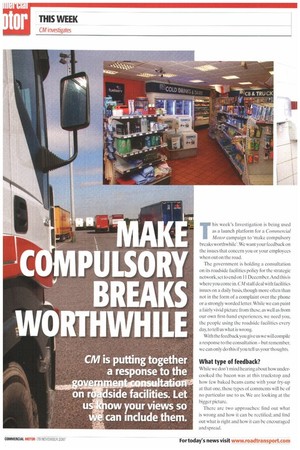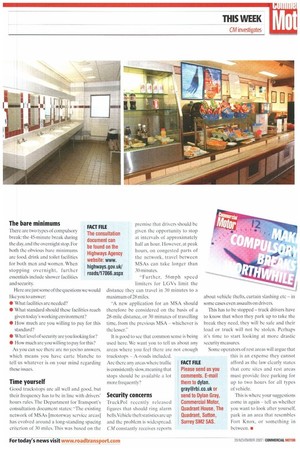CM is putting together
Page 32

Page 33

If you've noticed an error in this article please click here to report it so we can fix it.
a response to the
0420g° . _ tesonsultatio
on r side facilities. Let U ow your views so can include them.
This week's Investigation is being used as a launch platform for a Commercial Motor campaign to 'make compulsory breaks worthwhile'. We want your feedback on the issues that concern you or your employees when. out on the road.
The government is holding a consultation on its roadside facilities policy for the strategic network,set to end on 11 December. And this is where you come in. CM staff deal with facilities issues on a daily basis, though more often than not in the form of a complaint over the phone or a strongly worded letter. While we can paint a fairly vivid picture from these, as well as from our own first-hand experiences, we need you, the people using the roadside facilities every day, to tell us what is wrong.
With the feedback you give us we will compile a response to the consultation—but remember, we can only do this if you tell us your thoughts, What type of feedback?
While we don't mind hearing about how undercooked the bacon was at this truckstop and how few baked beans came with your fry-up at that one, these types of comments will be of no particular use to us. We are looking at the bigger picture.
There are two approaches: find out what is wrong and how it can be rectified; and find Out what is right and how it can be encouraged and spread. The bare minimums There are two types of compulsory break: the 45-minute break during the day, and the overnight stop. For both the obvious bare minimums are food, drink and toilet facilities for both men and women. When stopping overnight, further essentials include shower facilities and security.
Here are just some of the questions we would like you to answer: • What facilities are needed?
• What standard should these facilities reach given today's working environment?
• How much are you willing to pay for this standard?
• What level of security are you looking for?
• How much are you willing to pay for this?
As you can see there are no yes/no answers, which means you have carte blanche to tell us whatever is on your mind regarding these issues.
Time yourself Good truckstops are all well and good, but their frequency has to be in line with drivers' hours rules. The Department for Transport's consultation document states: The existing network of MSAs [motorway service areas] has evolved around a long-standing spacing criterion of 30 miles. This was based on the premise that drivers should be given the opportunity to stop at intervals of approximately half an hour. However, at peak hours, on congested parts of the network, travel between MSAs can take longer than 30 minutes.
"Further, 56mph speed limiters for LGVs limit the distance they can travel in 30 minutes to a maximum of 28 mi]es.
"A new application for an MSA should therefore be considered on the basis of a 28-mile distance, or 30 minutes of travelling time, from the previous MSA — whichever is the lesser."
It is good to see that common sense is being used here. We want you to tell us about any areas where you feel there are not enough truckstops — A-roads included. Are there any areas where traffic is consistently slow, meaning that stops should be available a lot more frequently?
Security concerns TruckPol recently released figures that should ring alarm bells.Vehicle theft statistics are up and the problem is widespread. CM constantly receives reports about vehicle thefts, curtain slashing etc — in some cases even assaults on drivers.
This has to be stopped — truck drivers have to know that when they park up to take the break they need, they will he safe and their load or truck will not be stolen. Perhaps it's time to start looking at more drastic security measures.
Some operators of rest areas will argue that this is an expense they cannot afford as the law clearly states that core sites and rest areas must provide free parking for up to two hours for all types of vehicle.
This is where your suggestions come in again — tell us whether you want to look after yourself, park in an area that resembles Fort Knox, or something in between. •






















































































































































































